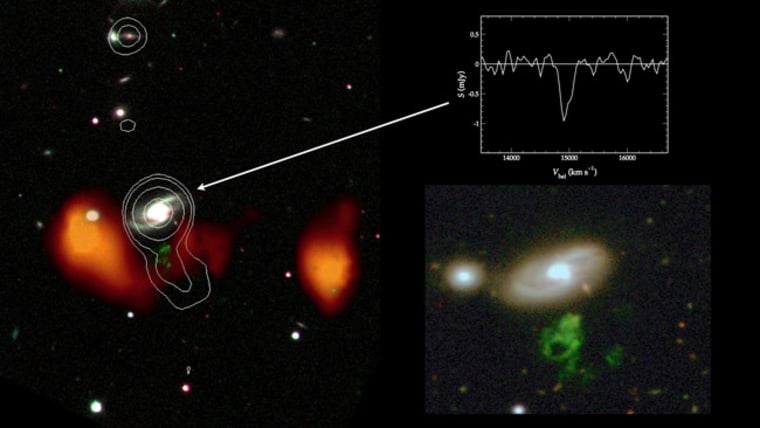An eerie green cloud lurking around a nearby galaxy has puzzled scientists since it was discovered last year. New observations reveal that the cloud's ghoulish appearance may have to do with radiation streaming from a black hole inside the galaxy.
The cloud was first discovered by Dutch schoolteacher Hanny van Arkel, who volunteered to sift through astronomical data as part of the Galaxy Zoo project. Van Arkel came across an image of a huge, irregular-shaped greenish-yellowish cloud near the spiral galaxy IC2497. The unusual object became known as "Hanny's Voorwerp," Dutch for "Hanny's thing."
The cloud itself is devoid of stars, so astronomers were unsure what was generating the green glow. Some suggested that radiation from a massive black hole in the center of the galaxy (called a quasar) could be the culprit, but until now no such black hole radiation had been visible.
"People had looked with X-ray telescopes and had not detected any quasar or black hole activity," said researcher Tom Oosterloo, an astronomer at the Netherlands Institute for Radio Astronomy. "But our new observations, in very high resolution, show that there is some activity. It's not spectacularly strong, but there is an active black hole."
Oosterloo and colleagues, led by Mike Garrett of the Netherlands Institute for Radio Astronomy and including van Arkel, used the Westerbork Synthesis Radio Telescope in the Netherlands and an array in the European Very Long Baseline Interferometry Network to observe Hanny's Voorwerp and IC2497.
The team found that a jet of highly energetic particles was indeed emanating from the galaxy, pointing directly at the Voorwerp. Because the jet was not directed toward Earth, it was difficult to detect.
The researchers think particles in this jet clear a path through the dense gas and dust around the galaxy, allowing radiation from the black hole to pour into a gas cloud partially encircling the galaxy. The optical and ultraviolet emission from the black hole excites particles in the gas cloud, which is mostly made of hydrogen with some oxygen and other elements. The heated-up gas emits the greenish light we see.
"In a way it's a cosmic accident," Oosterloo told SPACE.com. "This black hole activity happens a lot, and many galaxies have this cloud, but it happens very rarely that the black hole jet hits the cloud. It's not the only such object known, but it's quite an interesting case."
The gas cloud around the spiral galaxy likely came to be when a smaller galaxy flew by IC2497. The larger galaxy's gravitation pull would have tugged off some of the other's gas, keeping a blanket of material near it long after the smaller galaxy had moved away.
Van Arkel said she was happy to have gained new understanding of her voorwerp. "I'm happy we are making progress," she said. "Apparently the more we learn about the Voorwerp, the more intriguing it becomes."
